Transforming Corn
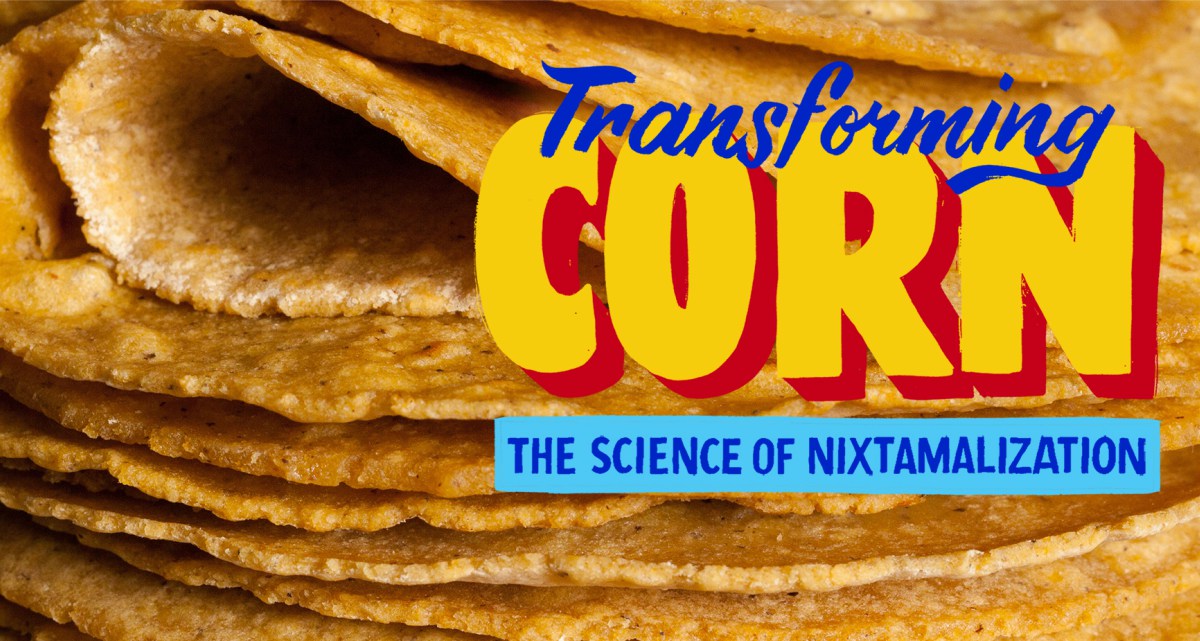
01
At Empellón
“Watch your head,” says chef Alex Stupak half a dozen times as we pick our way among low-hung ducts and overhangs in the extremely unprepossessing basement beneath New York’s Empellón Al Pastor. I am visiting the secret heart of Stupak’s fast-growing group of upscale Mexican restaurants: a small, steamy underground room where, every day, dried corn is made into dough for the exceptionally good fresh corn tortillas that are essential at Empellón.
Upstairs, and in the other Empellón restaurants around the city, where tortillas form the foundation of meals with intense flavors and an avant-garde attention to detail (Stupak spent four years as pastry chef at Wylie Dufresne’s modernist mecca WD-50), most customers likely have no idea that the clever way corn is transformed in the restaurant’s basement room is a technique not significantly changed from Mayan recipes of 1500 BC.
Try shaping ordinary cornmeal and water into a tortilla and you’ll notice a few hurdles right away. First, it doesn’t hold together as a dough no matter how long you soak or cook the grain; it crumbles and slumps into porridge. Unlike wheat, corn contains no gluten, nor any other structural element that would allow it to be shaped into a cohesive mass. Second, it doesn’t smell or taste like tortillas; it has the clean, papery scent of corn, but the familiar tortilla aroma—most familiar to most of us, perhaps, from corn chips—is something entirely different.
The difference is nixtamalization, a process that chemically changes the corn in a variety of interesting ways.
Every night, in the basement of Empellón, the process begins with 100 pounds of dried corn. Less than 5 percent of the world’s corn is the sweet variety meant to be picked and eaten fresh. The rest, used for bourbon, fuel, cereal, masa, and more, is dried in the field before it’s harvested. Empellón buys a flavorful white variety called olotillo blanco that’s grown in Mexico and imported by an heirloom corn wholesaler called Masienda.
The dry corn is brought to a near boil and then left to soak overnight in hot water with an added dose of cal—calcium hydroxide, also known as slaked lime or pickling lime. No relation whatsoever to the green citrus fruit, most slaked lime is produced by heating limestone, which is predominantly calcium carbonate (CaCO3), in an industrial oven, a process called calcination. This breaks the CaCO3 into carbon dioxide and calcium oxide. Adding water to the calcium oxide—“slaking” it—creates calcium hydroxide. Seashells, another source of calcium carbonate, can also be calcinated.
In the morning, the chef drains and rinses the nixtamalized corn (nixtamalized corn is called nixtamal), rubbing off some (but not all) of the loosened outer layer of the kernels.
The wet nixtamal is then milled between a pair of rotating grindstones: corn kernels go in, with a thin stream of water added, depending on the day’s humidity, and a silky, slightly elastic masa dough squiggles out the other end. After a knead to make sure the dough doesn’t have any overly dry or moist patches, it’s fed into a custom-built machine that flattens it into sheets, stamps out circles, feeds them through a series of heated iron conveyor belts, and emits a river of supple, fragrant finished tortillas.
02
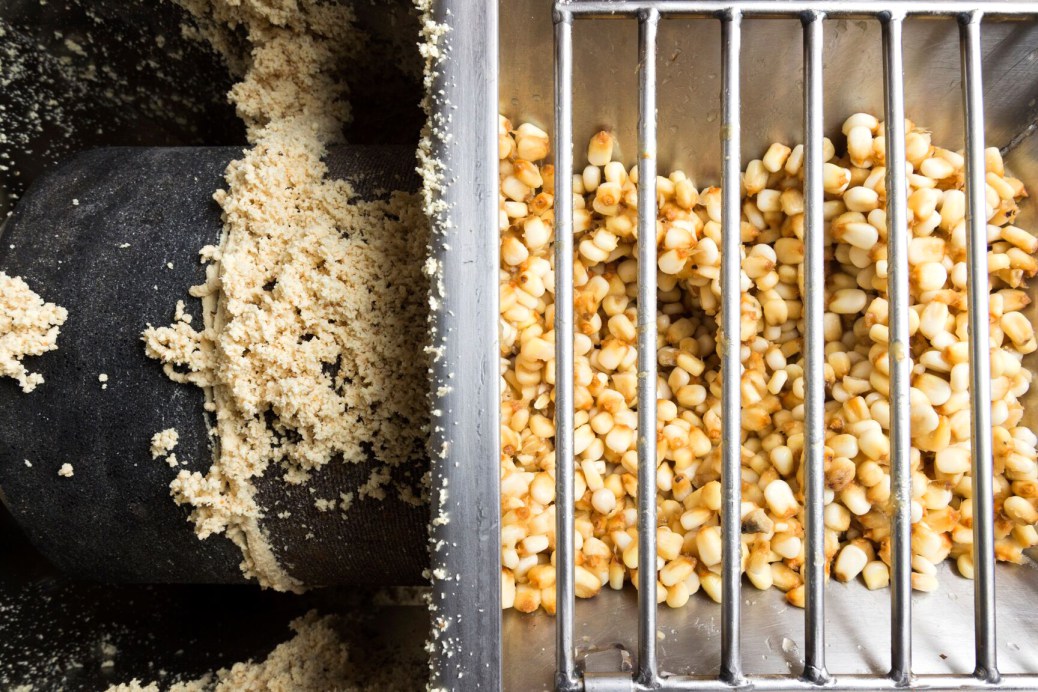
How Does Nixtamalization Work?
When dried corn steeps in a warm alkaline solution (nixtamalization), a number of useful chemical transformations take place.
Almost immediately, the color of the corn brightens and intensifies as the rise in pH alters its pigment compounds, deepening the yellows of xanthophylls and, in some varieties, darkening the pink of anthocyanins. Pale white corn turns yellow; yellow corn goes orange; deep purple corn transforms into vivid red.
Next, a complex, inviting aroma develops and fills the room. This buttery, earthy “corn chip flavor” consists of a combination of flavor chemicals that are present in minute quantities in nixtamalized corn.
Although the identities of these chemicals have been analyzed, the exact processes that lead to the burst of aroma are not fully understood. Jacob Lahne, an assistant professor of food science at Drexel University who specializes in flavor, explains three steps that likely happen in tandem during the cal soak: (1) nixtamalization “probably breaks up a number of the proteins and carbohydrates in the corn, potentially producing volatile compounds”; (2) it “may cause flavor compounds that are normally not soluble in water to become more so”; and (3) the softening of the corn structure allows volatile flavor compounds to be released where they were previously locked away in the kernel.
The most distinctive of these compounds is 2-aminoacetophenone, which is believed to be produced when the cal breaks down the amino acid tryptophan in the corn. Although there’s not a lot of tryptophan in corn, there’s enough to affect flavor, says Keith Cadwallader, professor of food chemistry at the University of Illinois. He explains, “2-aminoacetophenone is a powerful odorant and not much is needed to have an impact.”
It turns out that 2-aminoacetophenone is also present in chestnut honey—sniff some and see—and in Concord grapes.
Meanwhile, the caustic alkaline solution of cal—its pH is 12.4—partially degrades the plant’s cell walls. Cooks who handle cal must be careful to keep it off their skin and other sensitive membranes to avoid irritation and be sure to rinse the nixtamal well after the soak to get any remnants out. Because of its high alkalinity, rinse water from large-scale nixtamalizing operations can cause pollution problems if it’s not properly handled.
Two components of the rigid plant cell walls, pectin and hemicellulose, dissolve during the process of nixtamalization, losing the rigid matrix structure that gives the corn its toughness. This causes the hard, shiny hull of the kernel to soften and separate from the grain, so that it can easily be rubbed off and rinsed away when the corn is drained.
These gummy dissolved molecules of pectin, which reside in the interior of the kernel as well as in whatever percentage of the hull the chef opts to not wash away, are what will allow the corn to be formed into a cohesive dough after it’s ground. How? Individual molecules of pectin have the shape of long branching chains. When there’s calcium in their vicinity—as there is in the calcium hydroxide solution used for nixtamalization—adjacent pectin chains grab onto each other, a phenomenon called cross-linking. This cross-linking forms a mesh of pectin, which holds onto water, binding it into a gel. (Pectin gel is also the active ingredient that makes jams and jellies do what they do.) Some of the pectin and hemicellulose molecules break apart during nixtamalization as well, releasing gummy sugars that also help bind the dough together.
In masa dough, the gelled molecules trap water and water molecules stick to other water molecules, so masa holds together as long as it’s moist. But the dough doesn’t stay moist for very long—water escapes into the air and also gets pulled out of the gel structure into the dough’s own starches, where it can’t help the masa cohere. As Stupak says, masa is “a weird semi-gel, semi-non-gel hydrocolloidal mix that ideally you use right away.”
At Empellón, they cook all day with the tortillas made from each morning’s batch of masa dough. But, says Stupak, “the dough is never going to be as good as it is” immediately out of the mill. Freshness is everything. “So the same way that in France everyone lines up in the morning at their favorite bakery to buy their baguettes, that’s how Mexico is with tortillas.”
Hence the delight of making your own masa, and your own tortillas, from scratch. The taste and texture of a tortilla that’s still warm from the griddle where it was born is a different animal from any lesser tortilla.
03
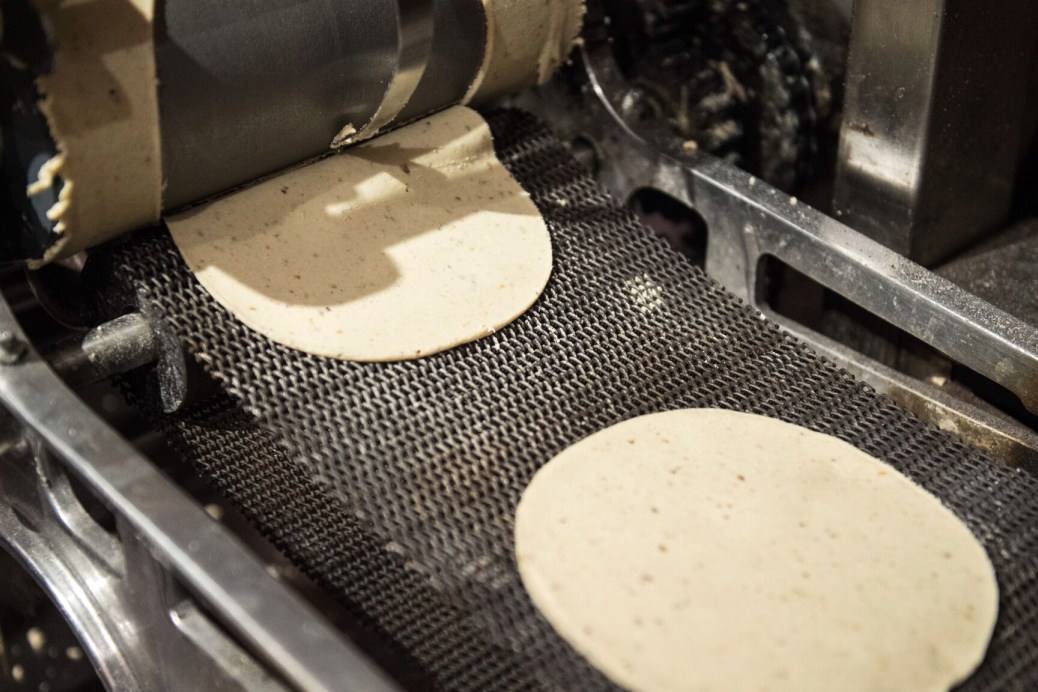
Vampires: In Need of Nixtamalization
The final transformation of corn during nixtamalization might be the most crucial, at least it was to the American civilizations that have survived on a corn-based diet for millennia: it becomes more nutritious.
When Christopher Columbus brought corn back from the New World, it became a staple food in rural communities throughout Europe over the next couple of centuries. Unfortunately, he did not bring back the technique of nixtamalization. Therefore, many people dependent on corn in those rural European communities developed symptoms including peeling, scaly skin that was painful when exposed to sunlight (according to one theory, this gave rise to the legend of sun-averse vampires); hair loss; and dementia. The mysterious disease was given the name pellagra, from the Italian for “sour skin,” but it wasn’t until the 20th century that science figured out that the disease wasn’t caused by a poison in corn but rather a deficiency in diet.
Corn is naturally abundant in niacin (aka vitamin B3), which is an essential part of the human diet. However, the niacin in corn is chemically bound to other molecules, so we humans cannot properly absorb it. If you try to subsist on a diet based around nothing but corn prepared without alkaline treatment, you will develop niacin deficiency—which, it turns out, is pellagra.
Somehow, though, prehistoric Mesoamericans took advantage of the way that cooking corn in an alkaline solution frees the bound niacin, shifts the balance of proteins, and turns corn into a nutritionally complete staple food. Ken Albala is director of food studies at the University of the Pacific and a historian of food. How nixtamalization first happened, he says, “is not recorded anywhere. There’s no way to tell the date. You can’t really pound corn, and it’s hard to mill. Someone wondered, ‘How do you soften it?’ Someone used limestone or burnt shells or wood ash, and the people who figured out how to do it, they survived.”
04
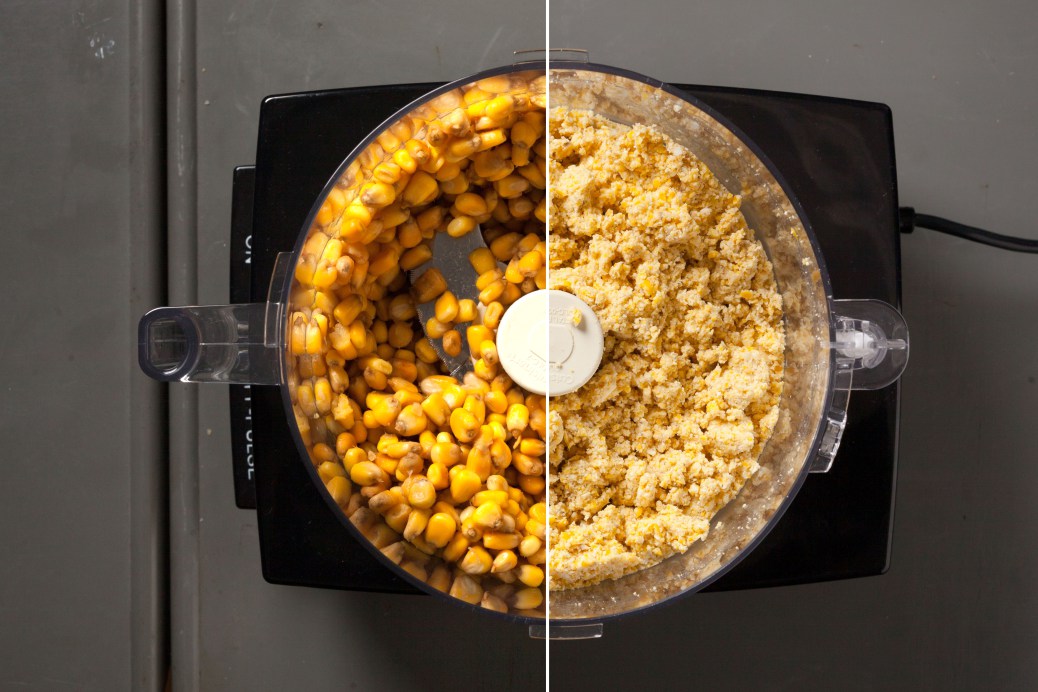
Advanced Topics in Nixtamalization
Tortillas are not the only use for nixtamalized corn. Tortilleria Nixtamal, in Queens, New York, which makes fresh masa every day and sells it to restaurants throughout the city, showcases other uses of nixtamalized corn as well. In addition to a variety of tacos, the casual restaurant above the little factory serves a sizeable corn-based menu.
A savory posole soup floats plump kernels of nixtamalized corn alongside shreds of meat in a rich pork broth. To make large, delicate tamales, the chef whips a more coarsely ground masa with lard into a light and airy batter, then folds this thickly around a meat or vegetable filling and steams it in corn husks until it’s firm yet tender. Champurrado, a traditional Mexican Christmas beverage, is like hot chocolate thickened with toasted masa.
Like many taquerias, Nixtamal also makes its own tortilla chips for nachos and dipping into guacamole, by cutting up tortillas and deep-frying them. Chips made this way are thin, smooth, caramel-colored triangles that shatter sharply when bitten, rather than crunching like a store-bought tortilla chip. The very different texture of Tostitos-style bagged chips is because they’re not made with the same method as tortillas. The nixtamalized corn that goes into supermarket tortilla chips is cooked for significantly less time, so its starch absorbs less water. Its gelatinized hull is completely removed, not just partially, and the end result is a lighter, drier dough and a crunchier chip.
A handful of chefs have played around with putting this age-old technique to other, slightly weirder uses. Dave Arnold, founder of the Museum of Food and Drink in New York, makes tortillas and tortilla chips out of rye grains. The nixtamalized rye has a unique, addictive flavor.
Highly recommended—but, he says, “there are a few things you have to watch out for.” The hull on a rye grain is tougher than corn’s, too tough for lime to soften properly. So he starts off by soaking the grain in a solution of lye to dissolve the hulls.
Lye, or sodium hydroxide, is a much stronger base than cal, with a pH of 14.0. (Like the Richter scale, the pH scale is logarithmic, meaning that a solution with a pH of 13 is ten times more alkaline than one with a pH of 12.)
“But lye won’t develop that cal flavor,” he says, so after rinsing off the lye, Arnold uses a cal solution to nixtamalize the softened rye as though it were corn. The chemical processes are comparable, and the resulting flavor is in the same family, but with a unique, toasty rye-ish tang. “No reason you couldn’t do it to any grain,” he says. “All it needs is starch inside and a hard hull.”
At the restaurant Mugaritz in Spain, chef Andoni Luis Aduriz soaks vegetables and fruits in cal solution before cooking them, to achieve some unusual effects. Pectin is a key structural component of plant cells, not just in corn, and when those cells are given a source of free calcium, the pectin molecules cross-link together and form a strong gel.
When Aduriz soaks cubes of pumpkin in a cal solution before cooking them, that pectin gel is created in the outermost layers of the cubes, which are in direct contact with the cal. The gel holds its shape in the form of a solid skin, even after hours of cooking in sugar syrup, so that when the cubes are served in a dessert, they still have a firm exterior, while their long-simmered insides are creamy and soft.
In general, a pinch of cal added to the cooking water of any vegetables will keep them firmer, because the calcium strengthens the pectin, and greener, because the alkalinity slows the breakdown of chlorophyll in hot water.
Personally, I like to soak popcorn kernels in a cal solution at room temperature for just a few minutes, then wash and dry them. When they’re popped afterwards, the puffs are smaller, because the weakened hulls can’t build up as much pressure, but the flavor is intriguingly reminiscent of a tortilla.
05
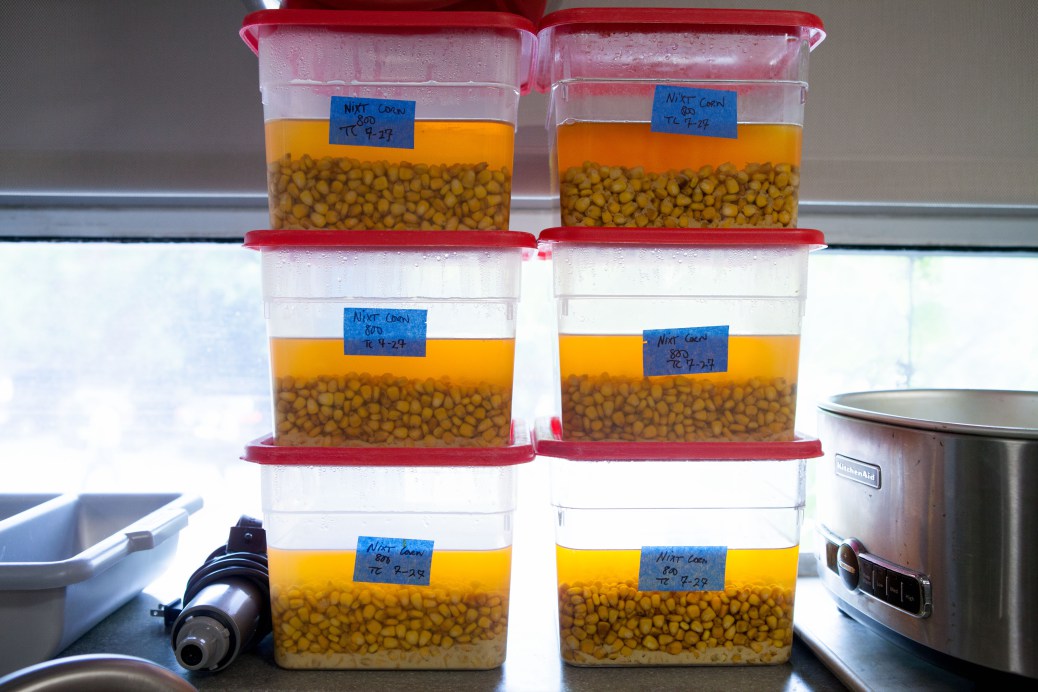
Back to the Test Kitchen
[Ed note: After Paul Adams delivered his nixtamalization treatise to the Cook’s Science team, Executive Editors Molly and Dan wanted to see the process with their own eyes. They headed to New York to spend the day with Stupak in his basement kitchen at Empellón Al Pastor. Soon after, Test Cook Tim Chin began developing his own recipes for the home cook. The following is from their perspective.]
Stupak and his team had nixtamalized a batch of white field corn from Oaxaca, Mexico overnight for the day’s service and he’d saved a small sample to demonstrate the process for the Cook’s Science team. After draining and rinsing the broad, flat white kernels Stupak fired up a big stone grinder, and pulverized them into a silky smooth, supple, warm-to-the-touch masa dough. The dough felt almost as smooth and pliable as fresh pasta dough, very different from the sandy, crumbly doughs made from store-bought masa harina and water.
Stupak soon explained that it’s just not possible to make this kind of dough at home. Without a stone grinder, he said, one cannot get the dough smooth enough.
And in a way he is right: At home you can’t make the super soft, impossibly pliable, ethereal tortillas that he serves at his restaurants. But after weeks of testing, Test Cook Tim Chin, found that you can certainly make the very best corn tortillas you’ll eat at home, at home.
Paul mentioned that he’s had the most success using a food processor to grind the corn, but that he had to add too much water in order to get it to grind properly. Daniel Gritzer at Serious Eats found the same thing when working on his recipe. Gritzer adds masa harina to absorb the excess moisture and make a dough that doesn’t stick to your hands or the tortilla press. However, Paul suggested drying the dough out in a low oven to avoid the added ingredient (and that pesky cornflake flavor). Tim’s recipe puts this drying step to great use in his recipe for Homemade Corn Tortillas.
Photography by Kevin White.
Food Styling by Elle Simone.
06
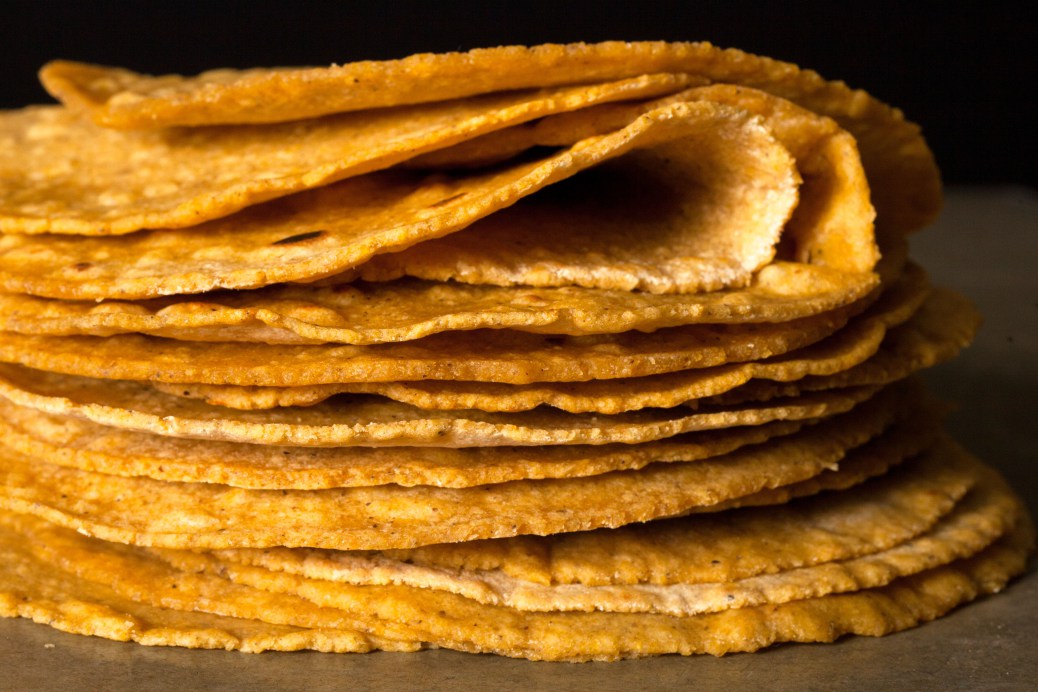
Recipes
We’ve put a lot of thought into how we present our recipes at Cook’s Science and we are excited to share some key features with you. First, we’ve provided ingredients in both grams and traditional US volume and weight measurements so you can work with whichever you prefer. You can toggle back and forth by clicking GRAMS or TRADITIONAL at the top of the ingredient list. We’ve never loved jumping back and forth between the ingredient list and procedure while we’re busy cooking so we’ve repeated the ingredients above the step where you need them. And finally, we’ve built in a pretty slick annotation feature to provide key information, photographs, and video throughout the recipe, without getting in the way of the clean, simple recipe view. Click on any of the yellow highlighted words to access the annotations. We hope you’ll check it all out and let us know what you think.
